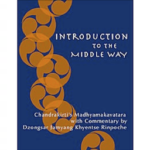
Madhyamakavatara – 8-Week Program Week 2 Pre-Reading
Summary
Date: 14 June
Topic: Wisdom and Compassion
Text: Madhyamakavatara (Introduction to the Middle Way) 1:1-6:7 (chapter 1 verse 1 to chapter 6 verse 7), pages 11 to 71 in the PDF version. (To download a copy, the instructions are here)
Questions: Why do we need to study and establish the view? Why can’t we just do our practice? What does progress on the path look like?
Keywords: compassion, path, ignorance, defilements
Also available: audio/video recordings and transcript/translations for Week 2.
Pre-Reading (Recommended)

Dzongsar Khyentse Rinpoche (2004) Introduction to the Middle Way
In Week 2 we will be covering the first 5 chapters of the Madhyamakavatara (Introduction to the Middle Way) and the first 7 verses of Chapter 6, pages 11 to 71 in the PDF version.
Pre-Reading (Optional)

Dzongsar Khyentse Rinpoche (2014) ➜Accumulation of Merit, teaching given at Bodhgaya
A short introduction to the six paramitas as the means for accumulating merit and wisdom, extracted from a teaching given at Bodhgaya. Chapters 1 to 5 of the Madhyamakavatara cover the first five of these six paramitas.

Garfield, Jay (2014) ➜”What Does Buddhism Require?”, New York Times, 27 April 2014
Buddhist scholar and professor Jay Garfield discusses the relationship of Buddhism, philosophy and religion in an interview with philosopher Gary Gutting. He talks about what it means to be a Buddhist, and touches on the relationship between emptiness and compassion, a key theme of the first five chapters of the Madhyamakavatara:
[Gutting]: “Won’t the fundamental denial of a self be hard to maintain in the face of the modern emphasis on individuality?”
[Garfield]: “I don’t think so. For one thing, note that the view that there is no substantial self has a history in the West as well, in the thought of Hume, and of Nietzsche. For another, note that many contemporary cognitive scientists and philosophers have either rejected the view that there is such a self, or have defended some variety of a minimalist conception of the self. So the doctrine isn’t as secure in the non-Buddhist world as one might think.
And this may be a good thing, not only for metaphysical reasons. A strong sense of self — of one’s own substantial reality, uniqueness and independence of others — may not be psychologically or morally healthy. It can lead to egoism, to narcissism and to a lack of care for others. So the modern emphasis on individuality you mention might not be such a good thing. We might all be better off if we each took ourselves less seriously as selves. That may be one of the most important Buddhist critiques of modernity and contributions to post-modernity.
More positively, the Buddhist tradition encourages us to see ourselves as impermanent, interdependent individuals, linked to one another and to our world through shared commitments to achieving an understanding of our lives and a reduction of suffering. It encourages us to rethink egoism and to consider an orientation to the world characterized by care and joint responsibility. That can’t be a bad thing.”

Garfield, Jay (2010) ➜”Buddhism in the West” [PDF], Info-Buddhism, 30 June 2010
Buddhist scholar and professor Jay Garfield explores how we can determine what is “authentic” Buddhism given the ways in which Buddhism has changed over the millennia and how the expression of the dharma continues to transform in the contemporary world:
Now when we look at this kind of panoply of changes wrought in the Buddhist tradition in the West and in Asia as a result of Buddhism’s interaction with the West, we might panic. We might say: “My God, It’s no longer authentic. It’s changed.” When we do that, we must remember to go back to ask the question: “What is Buddhism anyway? What makes a doctrine Buddhism?” Buddhism is fundamentally about solving a problem, and the problem is suffering. It’s fundamentally about a diagnosis of the cause of that problem, and the cause of that problem is attraction and aversion grounded in confusion. It’s grounded in the conviction that once we recognize that, the elimination of that confusion can solve the problem, and in a path to that solution. None of that has been abandoned; none of that has been fundamentally transformed, even though its articulation is transformed in countless ways.
He points out that the Buddhist tradition has a different way of talking about progress than the modern West, but that the Buddhist emphasis on the continuity of the lineage can obscure the extent to which there has been innovation:
When we see transformation or change, we instinctively think of degeneration, and that’s also part of Buddhist rhetoric. When you think about history from a Buddhist point of view it’s often thought of as degeneration from an omniscient teacher through more and more fallible human beings, and a kind of decline of the dharma. That’s part of the internal rhetoric of Buddhism. Whereas when we think in a Western context we think the other way around about history. We think about progress from a primitive to a more enlightened view, and when we think about Kant and his discussion of the Aufklärung, he was really talking about a progress and an emergence from darkness. Now those are two very different understandings of history.
My own view is that […] the Buddhist tradition is a deeply progressive tradition that is beset by anxiety about that progress. So you always see any Buddhist commentary begin by saying: “I’m not saying anything new. All I’m doing is repeating what’s been said before”, but if that was true nobody would read the commentary. If it’s all been said before, then why bother wasting a palm leaf? So we get this kind of self-deprecation of originality; but the people we value the most—people like Je Rinpoche, people like Gorampa, people like Mipham Rinpoche—are the most theoretically innovative and creative teachers in the Tibetan tradition; and the people to whose texts we return in the Indian tradition — people like Chandrakirti or Shantarakshita or Shantideva — we turn to precisely because they are building on what went before and they are innovating, even though given the internal rhetoric they have to talk about the decline of the dharma and how there is nothing original.

Berzin, Alexander (undated) ➜”Overview of the Six Perfections: Six Paramitas”, Study Buddhism
Buddhist scholar and professor Alexander Berzin offers an overview of the six paramitas, followed by longer posts on the individual paramitas. It is useful to have a background understanding of the six paramitas when reading the early chapters of the Madhyamakavatara, as Chandrakirti doesn’t go into any detail about them, presumably as his readers would have been familiar with the paramitas. Good introductions are available in Words of My Perfect Teacher and The Way of the Bodhisattva (see below), but for readers who don’t have access to those books, Berzin’s introduction offers a helpful overview:
(Overview) ➜Six paramitas
(1) ➜Generosity (danaparamita)
(2) ➜Ethical self-discipline (shilaparamita)
(3) ➜Patience (kshantiparamita)
(4) ➜Perseverance (viryaparamita)
(5) ➜Mental stability (concentration) (dhyanaparamita)
(6) ➜Discriminating awareness (wisdom) (prajñaparamita)
Books (Optional)

Patrul Rinpoche, trans. Padmakara (2010) Words of My Perfect Teacher (Revised Edition)
This classic introduction to the Tibetan Buddhist path includes a classic introduction to the six paramitas in Chapter 2: Arousing bodhicitta, the root of the Great Vehicle. The online article Overview of the Six Perfections: Six Paramitas by Alexander Berzin (see pre-reading below) and his longer posts on the individual paramitas cover much of the same material.
[available for purchase at ➜Amazon]

Shantideva, trans. Padmakara (2006) The Way of the Bodhisattva (Revised Edition)
Treasured by Buddhists of all traditions, The Way of the Bodhisattva (Bodhicharyavatara) is a guide to cultivating the mind of enlightenment, and to generating the paramitas – the qualities of love, compassion, generosity, and patience. This text has been studied, practiced, and expounded upon in an unbroken tradition since the 8th century, first in India, and later in Tibet. Presented in the form of a personal meditation in verse, it outlines the path of the Bodhisattvas—those who renounce the peace of individual enlightenment and vow to work for the liberation of all beings and to attain buddhahood for their sake.
[available for purchase at ➜Amazon]
Last updated 7 November 2017